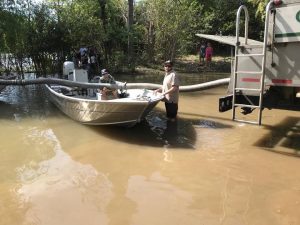 CHICO, California — On Saturday, April 13, the U.S. Fish and Wildlife Service released a total of 360,000 juvenile fall Chinook salmon on the Sacramento River in an three-year study aimed at increasing their survival on their long journey to the ocean.
CHICO, California — On Saturday, April 13, the U.S. Fish and Wildlife Service released a total of 360,000 juvenile fall Chinook salmon on the Sacramento River in an three-year study aimed at increasing their survival on their long journey to the ocean.
The service released 180,000 marked juvenile salmon into the Sacramento River at Scotty’s Landing near Chico, 75 miles downstream of where they were born, in the pilot project focusing on increasing the contribution of the Coleman National Fish Hatchery to California’s salmon fishery.
Agency staff released the second group of 180,000 upstream at the hatchery to compare their survival to the fish moved downstream. Current practice for the hatchery is to release fish directly into Battle Creek, some 320 miles from the ocean, said John Heil, U.S. Fish and Wildlife Service spokesman, in a statement.
Partners on the study include Golden Gate Salmon Association, NorCal Guides and Sportsmen’s Association, Pacific Coast Federation of Fishermen’s Associations, UC Davis and the Bureau of Reclamation.
“The study will test whether moving the salmon’s release point to 75 miles downstream from the hatchery on Battle Creek will improve their survival without causing more straying of returning adults,” said Heil. “According to studies done between 2007 and 2010, many Coleman salmon are lost in the first 75 miles of travel after release, especially in low water years.”
“The fish, moved via tanker truck to the Chico site, were released into an acclimation net pen floating in a side channel of the Sacramento River,” said Heil. “The net pen allows the fish to recover from stress and disorientation from the truck ride prior to release into the river. This reduces losses to predation upon release.”
Heil said all of the 360,000 fish were marked so that scientists can compare how the two groups survive, harvest and stray when they return two to four years from now. A subset of both release groups were also fitted with tiny acoustic tags by volunteers from UC Davis that allow monitoring of their migration. Acoustic tagging will provide “almost immediate data” on the outmigration and survival of juvenile salmon.
“GGSA worked with Coleman Hatchery, the NorCal Guides and Sportsmen’s Association, the Bureau of Reclamation, Pacific Coast Federation of Fishermen’s Associations and UC Davis to launch a three year experiment on Saturday,” said John McManus, President of the Golden Gate Salmon Association. “We want to see if we can boost survival of Coleman fish without appreciably increasing straying.”
“The fish were trucked 75 miles downstream and released into the Sacramento River,” said McManus. “Coleman produces 12 million fall run Chinooks annually. In a really good year, one percent (120,000) survive to be adults.”
“Imagine how much better things will be if we can boost survival by 2 to 4 times because every one percent increase equals 120,000 more adult salmon in the fishery. That’s the idea – to make what we already have go further,” McManus concluded.
The hatchery was established to partially mitigate for the loss of hundreds of miles of salmon habitat resulting from the construction of Shasta Dam, according to the agency. Because of its location near the upper end of the free-flowing Sacramento River, fish from this hatchery travel the furthest of any hatchery salmon in California to get to the ocean except Livingston Stone.
This journey can be perilous for juvenile salmon, since they are exposed to predators, the state and federal water pumping facilities on the South Delta and other unfavorable environmental conditions as they migrate to the ocean.
Here’s a video clip of the fish release described below from Saturday, shot by USFWS videographer Jake Sisco: https://drive.google.com/…/1T7WbmSeIaJ-D8e1i1Yhanna64…/view…
